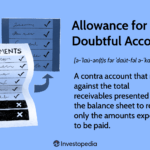What Is an Allowance for Doubtful Accounts?
An allowance for doubtful accounts is a contra account that nets against the total receivables presented on the balance sheet to reflect only the amounts expected to be paid. The allowance for doubtful accounts estimates the percentage of accounts receivable that are expected to be uncollectible. However, the actual payment behavior of customers may differ substantially from the estimate.
Key Takeaways
- The allowance for doubtful accounts is a contra account that records the percentage of receivables expected to be uncollectible, though companies may specifically trace accounts.
- The allowance is established in the same accounting period as the original sale, with an offset to bad debt expense.
- The percentage of sales method and the accounts receivable aging method are the two most common ways to estimate uncollectible accounts.
- Companies can also use specific identification, historical evidence, and or risk assignment to determine the estimate.
- The purpose of the allowance is to use the matching principle between revenue and expenses while also reporting the net amount of assets using the conservatism principle.
Allowance for Doubtful Accounts
Understanding the Allowance for Doubtful Accounts
Regardless of company policies and procedures for credit collections, the risk of the failure to receive payment is always present in a transaction utilizing credit. Thus, a company is required to realize this risk through the establishment of the allowance for doubtful accounts and offsetting bad debt expense. In accordance with the matching principle of accounting, this ensures that expenses related to the sale are recorded in the same accounting period as the revenue is earned. The allowance for doubtful accounts also helps companies more accurately estimate the actual value of their account receivables.
Because the allowance for doubtful accounts is established in the same accounting period as the original sale, an entity does not know for certain which exact receivables will be paid and which will default. Therefore, generally accepted accounting principles (GAAP) dictate that the allowance must be established in the same accounting period as the sale, but can be based on an anticipated or estimated figure. The allowance can accumulate across accounting periods and may be adjusted based on the balance in the account.
Companies technically don’t need to have an allowance for doubtful account. If it does not issue credit sales, requires collateral, or only uses the highest credit customers, the company may not need to estimate uncollectability.
How to Estimate the Allowance for Doubtful Accounts
Two primary methods exist for estimating the dollar amount of accounts receivables not expected to be collected.
Percentage of Sales Method
The sales method applies a flat percentage to the total dollar amount of sales for the period. For example, based on previous experience, a company may expect that 3% of net sales are not collectible. If the total net sales for the period is $100,000, the company establishes an allowance for doubtful accounts for $3,000 while simultaneously reporting $3,000 in bad debt expense.
If the following accounting period results in net sales of $80,000, an additional $2,400 is reported in the allowance for doubtful accounts, and $2,400 is recorded in the second period in bad debt expense. The aggregate balance in the allowance for doubtful accounts after these two periods is $5,400.
Accounts Receivable Aging Method
The second method of estimating the allowance for doubtful accounts is the aging method. All outstanding accounts receivable are grouped by age, and specific percentages are applied to each group. The aggregate of all group results is the estimated uncollectible amount.
For example, a company has $70,000 of accounts receivable less than 30 days outstanding and $30,000 of accounts receivable more than 30 days outstanding. Based on previous experience, 1% of accounts receivable less than 30 days old will be uncollectible, and 4% of those accounts receivable at least 30 days old will be uncollectible.
Therefore, the company will report an allowance of $1,900 (($70,000 * 1%) + ($30,000 * 4%)). If the next accounting period results in an estimated allowance of $2,500 based on outstanding accounts receivable, only $600 ($2,500 – $1,900) will be the adjusting entry amount.
Risk Classification Method
Some companies may classify different types of debt or different types of vendors using risk classifications. For example, a start-up customer may be considered a high risk, while an established, long-tenured customer may be a low risk. In this example, the company often assigns a percentage to each classification of debt. Then, it aggregates all receivables in each grouping, calculates each group by the percentage, and records an allowance equal to the aggregate of all products.
Historical Percentage Method
If a company has a history of recording or tracking bad debt, it can use the historical percentage of bad debt if it feels that historical measurement relates to its current debt. For example, a company may know that its 10-year average of bad debt is 2.4%. Therefore, it can assign this fixed percentage to its total accounts receivable balance since more often than not, it will approximately be close to this amount. The company must be aware of outliers or special circumstances that may have unfairly impacted that 2.4% calculation.
Pareto Analysis Method
A Pareto analysis is a risk measurement approach that states that a majority of activity is often concentrated among a small amount of accounts. In many different aspects of business, a rough estimation is that 80% of account receivable balances are made up of a small concentration (i.e. 20%) of vendors. This 80%/20% ratio is used throughout business.
Though the Pareto Analysis can not be used on its own, it can be used to weigh accounts receivable estimates differently. For example, a company may assign a heavier weight to the clients that make up a larger balance of accounts receivable due to conservatism.
Specific Identification Method
Assume a company has 100 clients and believes there are 11 accounts that may go uncollected. Instead of applying percentages or weights, it may simply aggregate the account balance for all 11 customers and use that figure as the allowance amount. Companies often have a specific method of identifying the companies that it wants to include and the companies it wants to exclude.
Management may disclose its method of estimating the allowance for doubtful accounts in its notes to the financial statements.
How to Account for the Allowance for Doubtful Accounts
Establishing the Allowance
The first step in accounting for the allowance for doubtful accounts is to establish the allowance. This is done by using one of the estimation methods above to predict what proportion of accounts receivable will go uncollected. For this example, let’s say a company predicts it will incur $500,000 of uncollected accounts receivable.
To create the allowance, the company must debit a loss. Most often, companies use an account called ‘Bad Debt Expense’. Then, the company establishes the allowance by crediting an allowance account often called ‘Allowance for Doubtful Accounts’. Though this allowance for doubtful accounts is presented on the balance sheet with other assets, it is a contra asset that reduces the balance of total assets.
- DR Bad Debt Expense $500,000
- CR Allowance for Doubtful Accounts $500,000
Adjusting the Allowance
Let’s say six months passes. The company now has a better idea of which account receivables will be collected and which will be lost. For example, say the company now thinks that a total of $600,000 of receivables will be lost. This means its allowance of $500,000 is $100,000 short. The company must record an additional expense for this amount to also increase the allowance’s credit balance.
- DR Bad Debt Expense $100,000
- CR Allowance for Doubtful Accounts $100,000
Note that if a company believes it may recover a portion of a balance, it can write off a portion of the account.
Writing Off Account
Now, let’s say a specific customer that owes a company $50,000 officially files for bankruptcy. This client’s account had previously been included in the estimate for the allowance. Because the company has a very low priority claim without collateral to the debt, the company decides it is unlikely it will every receive any of this $50,000. To properly reflect this change, the company must reduce its accounts receivable balance by this amount. On the other hand, once the receivable is removed from the books, there is no need to record an associated allowance for this account.
- DR Allowance for Doubtful Accounts $50,000
- CR Accounts Receivable $50,000
Note that the debit to the allowance for doubtful accounts reduces the balance in this account because contra assets have a natural credit balance. Also, note that when writing off the specific account, no income statement accounts are used. This is because the expense was already taken when creating or adjusting the allowance.
Recovering an Account
By miracle, it turns out the company ended up being rewarded a portion of their outstanding receivable balance they’d written off as part of the bankruptcy proceedings. Of the $50,000 balance that was written off, the company is notified that they will receive $35,000.
The company can recover the account by reversing the entry above to reinstate the accounts receivable balance and the corresponding allowance for doubtful account balance. Then, the company will record a debit to cash and credit to accounts receivable when the payment is collected. You’ll notice that because of this, the allowance for doubtful accounts increases. A company can further adjust the balance by following the entry under the “Adjusting the Allowance” section above.
- DR Accounts Receivable $35,000
- CR Allowance for Doubtful Accounts $35,000
- DR Cash $35,000
- CR Accounts Receivable $35,000
How Do You Record the Allowance for Doubtful Accounts?
You record the allowance for doubtful accounts by debiting the Bad Debt Expense account and crediting the Allowance for Doubtful Accounts account. You’ll notice the allowance account has a natural credit balance and will increase when credited.
Is Allowance for Doubtful Accounts a Credit or Debit?
The Allowance for Doubtful Accounts account is a contra asset. Contra assets are still recorded along with other assets, though their natural balance is opposite of assets. While assets have natural debit balances and increase with a debit, contra assets have natural credit balance and increase with a credit.
Are Allowance for Doubtful Accounts a Current Asset?
Yes, allowance accounts that offset gross receivables are reported under the current asset section of the balance sheet. This type of account is a contra asset that reduces the amount of the gross accounts receivable account.
Why Do Accountants Use Allowance for Doubtful Accounts?
Accounts use this method of estimating the allowance to adhere to the matching principle. The matching principle states that revenue and expenses must be recorded in the same period in which they occur. Therefore, the allowance is created mainly so the expense can be recorded in the same period revenue is earned.
The Bottom Line
The allowance for doubtful accounts is a general ledger account that is used to estimate the amount of accounts receivable that will not be collected. A company uses this account to record how many accounts receivable it thinks will be lost. The balance may be estimated using several different methods, and management should periodically evaluate the balance of the allowance account to ensure the appropriate bad debt expense and net accounts receivables are being recorded.



